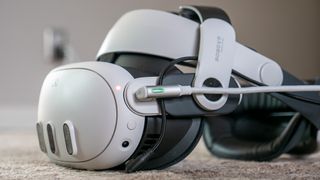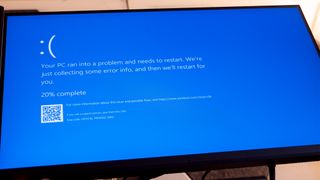Even the new Quest Link software can't save PCVR for me
I wish it would work for me, but it just doesn't.

I want to love PCVR, I really do. I have incredibly fond memories of the early days of modern consumer VR — specifically with the HTC Vive — and its SteamVR-powered experience. I've spent hundreds of hours in PC-only headsets over the years, and while all of them used different tracking methods, controllers, displays, and other components, all of them have been peppered with the exact same problems: they require as many hours of troubleshooting as you'll plan to play on them.

In his weekly column, Android Central Senior Content Producer Nick Sutrich delves into all things VR, from new hardware to new games, upcoming technologies, and so much more.
It's more than likely that I'm cursed in some regard to PC gaming, but I've never had an easy time of the effort. I'm aware of the flak I'm going to receive from the hardcore community for this article, but I know I'm not alone in my struggles. PC gaming seldom works for me and, even when it does, the trade-offs are almost often never worth the effort that goes into making it work.
This past week, Meta relaunched its Meta Quest Link software for the Meta Quest 3, Quest Pro, and Quest 2, and it made me wonder if the new improvements would be a notable improvement on my historically bad experience.
Turns out, it wasn't.
Have you tried turning it off and on again?

I come from an IT background of 15 years where I spent time as both a help desk technician and a systems administrator. I'm extremely familiar with computers, the individual components, and have been since I was a kid. I built my first computer from scratch when I was 12 and was an avid PC gamer for most of my life.
But the years of tweaking and troubleshooting have grown on my nerves. Things were never worse than when I was knee-deep in the PCVR scene with the HTC Vive and the Oculus Rift S, two PC headsets that I loved but didn't love me back. I can recall spending an hour troubleshooting audio problems nearly every night when my wife and I would play Beat Saber, and the problems never got better as the headsets improved.
Today, PCVR has the potential to be more effortless than ever. Realistically, all you need is the Steam Link app on your Meta Quest headset, and you can wirelessly play PCVR games with almost no setup. That is, so long as you have one of the best routers that's capable of delivering low latency and high bandwidth between your PC and Quest.
Be an expert in 5 minutes
Get the latest news from Android Central, your trusted companion in the world of Android
Somehow, even a wired PCVR experience will fail me when it should be the simplest method to use.
Unfortunately, for me, my old Wi-Fi 6 mesh router stopped working and I'm using an older router with less-than-adequate wireless speeds for PCVR use. That means I've got to wire up my headset like it was 2016 if I want to play PCVR games.
Simple enough, you say. Just plug the thing in and launch the Quest Link app, right? I wish.
Over the weekend, I jumped into the latest beta of Contractors Showdown to see how different the game looked on PC versus the native Quest version. There are some marked differences between the two, but I was surprised by how soft the image was compared to the native Quest version.
I tweaked some settings but could never get rid of that telltale "compressed" look. It was a good enough experience, but I was left at least a little disappointed by the result. Still, it worked well enough... that is, until the next day when I went to play another round with some friends.

I plugged the cable in and heard the good old "da dunk" connection sound Windows makes when something gets plugged in and recognized. Except the Quest Link software said the headset wasn't connected. I then put the Quest on, clicked the Quest Link button on the dashboard, and it said no PC found.
So I did what any self-respecting IT expert would do: I turned it off and on again.
Then I unplugged it, left it off for 20 seconds, and plugged it back in again. Wash, rinse, repeat. I even tried another cable since I've got two or three lying around, but the PC refused to recognize my connected headset.
Gaming on a Quest is so much more effortless than any other way to VR.
Ironically, Air Link worked immediately when I clicked the toggle in the headset, but I quickly remembered why I could not play this way. The latency between my movements and the in-game character's movements made the game completely unplayable. And the fact that a VHS tape delivered better quality than my wireless streaming setup didn't help things.
Instead, I unplugged everything and started up the native Contractors Showdown game running on the Quest itself. Guess what? It worked.
It always works when it's on Quest — aside from a scant few hiccups here and there — and that's part of why I love the Quest experience so much. It's a console. You put it on your head and play. It's the thing that immediately sold me on Quest when I used the original unit back in 2019 and why I almost never use any other headset to play VR games.
I fully recognize the advantages PCVR games could have. I just wish the tech would work for me.
I've written off PCVR more times than I can count, so why do I still seem to come back for more? The answer is that I fully recognize the serious advantages PCVR games could potentially have over Quest games.
Better graphics are just the start. Many SteamVR games are Steam Workshop enabled and can be easily modded. Half-Life: Alyx is a deal not just because of Valve's masterful storytelling but also because the modding community has produced some truly brilliant works of art with it.
But I rarely experience this because PCVR doesn't work for me on a technical level. No matter what I do, and no matter how hard I try, things never seem to get better. At the very least, even if I can get it working once, I seldom repeat the experience two days in a row. And, for that, I may very well be writing off PCVR forever.
Anyone want to buy a PC? I might be selling one.

-
rchapman80 I've had the opposite experience. I'm running a Quest 1 connected to my PC for sim racing and I really haven't had an issue. Granted I want to get an upgraded version for better fidelity and refresh rate but I haven't had much problem. I only use it by itself or connected to my PC for sim racing which I find amazing. I'm sorry you are having this experience because it has taken my immersion to the next level sitting behind a GT car running around Sebring.Reply -
mavthedemonwolf I never had any issues with my Rift S since I bought it in 2019 or so. Used it until recently when I decided to "upgrade" and give the Quest 2 a try (despite the fact that I despise Facebo- I mean uh... "Meta" (still a ridiculous name, prove me wrong). I don't bother using my Quest 2 for anything aside from PCVR and I've had nothing but issues out of it as long as I've had it. I was even dumb enough to cough up the $80 for the "official" link cable. Still a list longer than Santa's naughty list of issues. I know you might ask why I don't use it standalone then, but it's primarily because I some games I play either don't have cross play between PCVR and PC or solely because of such terrible graphics. The graphics on Standalone actually make me feel sick to my stomach at times whereas PCVR is fine for me.Reply
If you ask me, it's just that Facebook wanted to keep folks with a Quest off of PCVR and sell subpar and inferior games and apps on their own storefront. -
greenswedd For the best wireless PCVR experience, please consider purchasing a standalone and decent Wi-Fi router that you simply plug in to your PC, and use that to exclusively connect your Quest with the Virtual Desktop app. The app has worked so much better for me than Meta's own solution.Reply -
Ragobi Absolutely a skill issue. Nobody builds a pc from "scratch". You were not IBM at the age of 12. I highly doubt you have much real experience with computers at all.Reply -
DarrinMU I was surprised to read this. I use PCVR, and it is my favorite way of playing. Yes, it was definitely a challenge in the beginning when I didn't know the whole router thing. That said, I got a Netgear Nighthawk router in my office and it works great with Oculus Sync. The load times are a little long, but the games work great except for the occasional crash. I've played Valheim, No Man's Sky, Skyrim, Legendary Tales and Half Life Alex. All work well even though my computer is a little sub par.Reply -
itamargs Don't give up!Reply
I felt like you but than i discovered "Virtual Desktop"
It's what meta quest link should have been.
You need to install the client app on the quest and the streamer app on you PC. There are good tutorials on YouTube but for me its pretty much working out of the box.
Quest link was a disaster for me but i found virtual desktop to be very stable.
